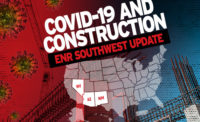Pandemic Drives Design Trends in the Southwest

Architecture firms were enjoying a decade of economic recovery before the pandemic changed practices forever. In 2022, architects are quickly learning to navigate through unprecedented circumstances while providing clients with the highest level of service. Design trends and innovation lie within the silver lining—and there is a silver lining.
Michele K. Brigida, principal of Carpenter Sellers Del Gatto Architects in Las Vegas, reports that CSD is working on its first project utilizing integrated project delivery.
“Projects put on hold in early 2020 are coming back post-pandemic and facing a myriad of challenges, such as redesign, change orders and labor shortages in the office and field,” Brigida says.

Dwayne R. Eshenbaugh
In CSD’s higher education projects, the firm has reprogrammed space to include smaller classrooms and more green rooms for online sessions and virtual program recording. Additionally, “open spaces incorporating nature and wellness are being programmed into buildings—it’s no longer just about [good] indoor air quality,” she says.
Benjamin Gardner, CEO of Dekker/Perich/Sabatini in Albuquerque, says the 190-person firm “is working with private and public owners who are pre-purchasing building materials and stocking up” due to supply-chain delays. Early procurement—now 26 weeks for roofing membrane and HVAC equipment—requires making design decisions earlier in the process and limits change orders. Gardner adds that “costs have escalated everywhere,” including a 60% increase in the dollar per square foot construction cost of K-12 facilities. While that’s alarming, the firm is seeing “more capital infused into public projects primarily due to the rebound of New Mexico’s oil and gas industry,” Gardner says.
Diane R. Jacobs, principal of Holly Street Studio in Phoenix, is working on the city of Mesa and Arizona State University’s Media and Immersive eXperience (MIX) Center in downtown Mesa, as well as other community projects for Tempe and Peoria, Ariz. Jacobs acknowledges a shortage of “critical staff” with advanced technical and design experience. However, emerging professionals are jumping in quickly to learn all facets of practice.
Jacobs emphasizes direct collaboration with owners, consultants and contractors during construction. “No more working in silos. As like-minded professionals, we now must overlap in both vision and implementation to keep pace with current building industry needs,” she says.
General Trends
In terms of staffing, firms have never fully recovered from the 2008 recession when many mid-level architects and staff abandoned the industry to pursue other career interests. That means firm principals and senior staff are moving into the trenches as younger staff are being asked to step up and do more. This situation presents great opportunities for the transfer of knowledge from one generation to another.
Today, the key trends in design are rooted in technology. New ways of working and collaborating offer tremendous potential for connecting expertise, regardless of location. Advancements in technology allow architects to design intelligent buildings with less environmental impact and connect with our most precious resource—our staff.
Those are among the silver linings to be found among all this chaos.



